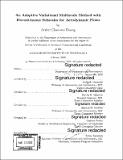An adaptive variational multiscale method with discontinuous subscales for aerodynamic flows
Author(s)
Huang, Arthur(Arthur Chan-wei)
Download1201259090-MIT.pdf (16.68Mb)
Other Contributors
Massachusetts Institute of Technology. Department of Aeronautics and Astronautics.
Advisor
David L. Darmofal.
Terms of use
Metadata
Show full item recordAbstract
A promising methodology for accurate and efficient simulation of aerodynamic flows is output-based mesh adaptation, which optimizes a mesh to minimize the discretization error in an output of interest. The state of the art in output-based adaptation uses the discontinuous Galerkin (DG) method, which is computationally expensive due to its duplicated degrees of freedom. Existing continuous Galerkin (CG) methods require up to 20 times fewer degrees of freedom, but lack the combination of stability and adjoint consistency required for output-based adaptation. This thesis presents a novel high order continuous Galerkin method, which is both adjoint consistent and stable. The scheme, called Variational Multiscale with Discontinuous subscales (VMSD), models unresolved solution perturbations with a discontinuous representation. The solution discontinuities are then used to stabilize the problem using methods borrowed from discontinuous Galerkin methods. At the same time, the mathematical structure of the discretization allows for the elimination of additional degrees of freedom in a computationally efficient manner, so that the method has a linear system of the same size as a conventional CG discretization. Finally, because the scheme is adjoint consistent, accurate error estimates can be obtained for use in an output-based mesh adaptation process. In this work, the method is derived and its optimal properties demonstrated through analysis and numerical experiment. In particular, the thesis describes the integration of VMSD in a high order adaptive method, namely the Mesh Optimization via Error Sampling and Synthesis (MOESS) algorithm. Adaptive DG and VMSD are compared for 3D RANS simulations. The adaptive VMSD method is shown to produces solutions with the same drag error as the adaptive DG method, with a factor of 3-10 fewer globally coupled degrees of freedom, and an associated factor of three or more reduction in computation time.
Description
Thesis: Ph. D., Massachusetts Institute of Technology, Department of Aeronautics and Astronautics, 2020 Cataloged from the PDF of thesis. Includes bibliographical references (pages 161-168).
Date issued
2020Department
Massachusetts Institute of Technology. Department of Aeronautics and AstronauticsPublisher
Massachusetts Institute of Technology
Keywords
Aeronautics and Astronautics.